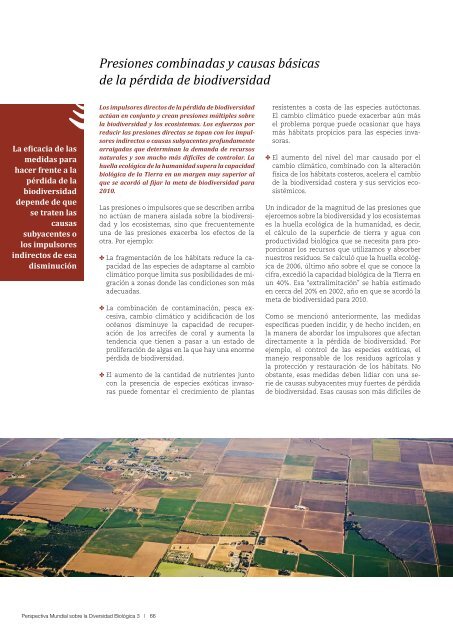Perspectiva Mundial sobre la Biodiversidad 3 - Convention on ...
Perspectiva Mundial sobre la Biodiversidad 3 - Convention on ...
Perspectiva Mundial sobre la Biodiversidad 3 - Convention on ...
Create successful ePaper yourself
Turn your PDF publications into a flip-book with our unique Google optimized e-Paper software.
Presi<strong>on</strong>es combinadas y causas básicas<br />
de <str<strong>on</strong>g>la</str<strong>on</strong>g> pérdida de biodiversidad<br />
La eficacia de <str<strong>on</strong>g>la</str<strong>on</strong>g>s<br />
medidas para<br />
hacer frente a <str<strong>on</strong>g>la</str<strong>on</strong>g><br />
pérdida de <str<strong>on</strong>g>la</str<strong>on</strong>g><br />
biodiversidad<br />
depende de que<br />
se traten <str<strong>on</strong>g>la</str<strong>on</strong>g>s<br />
causas<br />
subyacentes o<br />
los impulsores<br />
indirectos de esa<br />
disminución<br />
Los impulsores directos de <str<strong>on</strong>g>la</str<strong>on</strong>g> pérdida de biodiversidad<br />
actúan en c<strong>on</strong>junto y crean presi<strong>on</strong>es múltiples <str<strong>on</strong>g>sobre</str<strong>on</strong>g><br />
<str<strong>on</strong>g>la</str<strong>on</strong>g> biodiversidad y los ecosistemas. Los esfuerzos por<br />
reducir <str<strong>on</strong>g>la</str<strong>on</strong>g>s presi<strong>on</strong>es directas se topan c<strong>on</strong> los impulsores<br />
indirectos o causas subyacentes profundamente<br />
arraigadas que determinan <str<strong>on</strong>g>la</str<strong>on</strong>g> demanda de recursos<br />
naturales y s<strong>on</strong> mucho más difíciles de c<strong>on</strong>tro<str<strong>on</strong>g>la</str<strong>on</strong>g>r. La<br />
huel<str<strong>on</strong>g>la</str<strong>on</strong>g> ecológica de <str<strong>on</strong>g>la</str<strong>on</strong>g> humanidad supera <str<strong>on</strong>g>la</str<strong>on</strong>g> capacidad<br />
biológica de <str<strong>on</strong>g>la</str<strong>on</strong>g> Tierra en un margen muy superior al<br />
que se acordó al fijar <str<strong>on</strong>g>la</str<strong>on</strong>g> meta de biodiversidad para<br />
2010.<br />
Las presi<strong>on</strong>es o impulsores que se describen arriba<br />
no actúan de manera ais<str<strong>on</strong>g>la</str<strong>on</strong>g>da <str<strong>on</strong>g>sobre</str<strong>on</strong>g> <str<strong>on</strong>g>la</str<strong>on</strong>g> biodiversidad<br />
y los ecosistemas, sino que frecuentemente<br />
una de <str<strong>on</strong>g>la</str<strong>on</strong>g>s presi<strong>on</strong>es exacerba los efectos de <str<strong>on</strong>g>la</str<strong>on</strong>g><br />
otra. Por ejemplo:<br />
✤ La fragmentación de los hábitats reduce <str<strong>on</strong>g>la</str<strong>on</strong>g> capacidad<br />
de <str<strong>on</strong>g>la</str<strong>on</strong>g>s especies de adaptarse al cambio<br />
climático porque limita sus posibilidades de migración<br />
a z<strong>on</strong>as d<strong>on</strong>de <str<strong>on</strong>g>la</str<strong>on</strong>g>s c<strong>on</strong>dici<strong>on</strong>es s<strong>on</strong> más<br />
adecuadas.<br />
✤ La combinación de c<strong>on</strong>taminación, pesca excesiva,<br />
cambio climático y acidificación de los<br />
océanos disminuye <str<strong>on</strong>g>la</str<strong>on</strong>g> capacidad de recuperación<br />
de los arrecifes de coral y aumenta <str<strong>on</strong>g>la</str<strong>on</strong>g><br />
tendencia que tienen a pasar a un estado de<br />
proliferación de algas en <str<strong>on</strong>g>la</str<strong>on</strong>g> que hay una enorme<br />
pérdida de biodiversidad.<br />
✤ El aumento de <str<strong>on</strong>g>la</str<strong>on</strong>g> cantidad de nutrientes junto<br />
c<strong>on</strong> <str<strong>on</strong>g>la</str<strong>on</strong>g> presencia de especies exóticas invasoras<br />
puede fomentar el crecimiento de p<str<strong>on</strong>g>la</str<strong>on</strong>g>ntas<br />
resistentes a costa de <str<strong>on</strong>g>la</str<strong>on</strong>g>s especies autóct<strong>on</strong>as.<br />
El cambio climático puede exacerbar aún más<br />
el problema porque puede ocasi<strong>on</strong>ar que haya<br />
más hábitats propicios para <str<strong>on</strong>g>la</str<strong>on</strong>g>s especies invasoras.<br />
✤ El aumento del nivel del mar causado por el<br />
cambio climático, combinado c<strong>on</strong> <str<strong>on</strong>g>la</str<strong>on</strong>g> alteración<br />
física de los hábitats costeros, acelera el cambio<br />
de <str<strong>on</strong>g>la</str<strong>on</strong>g> biodiversidad costera y sus servicios ecosistémicos.<br />
Un indicador de <str<strong>on</strong>g>la</str<strong>on</strong>g> magnitud de <str<strong>on</strong>g>la</str<strong>on</strong>g>s presi<strong>on</strong>es que<br />
ejercemos <str<strong>on</strong>g>sobre</str<strong>on</strong>g> <str<strong>on</strong>g>la</str<strong>on</strong>g> biodiversidad y los ecosistemas<br />
es <str<strong>on</strong>g>la</str<strong>on</strong>g> huel<str<strong>on</strong>g>la</str<strong>on</strong>g> ecológica de <str<strong>on</strong>g>la</str<strong>on</strong>g> humanidad, es decir,<br />
el cálculo de <str<strong>on</strong>g>la</str<strong>on</strong>g> superficie de tierra y agua c<strong>on</strong><br />
productividad biológica que se necesita para proporci<strong>on</strong>ar<br />
los recursos que utilizamos y absorber<br />
nuestros residuos. Se calculó que <str<strong>on</strong>g>la</str<strong>on</strong>g> huel<str<strong>on</strong>g>la</str<strong>on</strong>g> ecológica<br />
de 2006, último año <str<strong>on</strong>g>sobre</str<strong>on</strong>g> el que se c<strong>on</strong>oce <str<strong>on</strong>g>la</str<strong>on</strong>g><br />
cifra, excedió <str<strong>on</strong>g>la</str<strong>on</strong>g> capacidad biológica de <str<strong>on</strong>g>la</str<strong>on</strong>g> Tierra en<br />
un 40%. Esa “extralimitación” se había estimado<br />
en cerca del 20% en 2002, año en que se acordó <str<strong>on</strong>g>la</str<strong>on</strong>g><br />
meta de biodiversidad para 2010.<br />
Como se menci<strong>on</strong>ó anteriormente, <str<strong>on</strong>g>la</str<strong>on</strong>g>s medidas<br />
específicas pueden incidir, y de hecho inciden, en<br />
<str<strong>on</strong>g>la</str<strong>on</strong>g> manera de abordar los impulsores que afectan<br />
directamente a <str<strong>on</strong>g>la</str<strong>on</strong>g> pérdida de biodiversidad. Por<br />
ejemplo, el c<strong>on</strong>trol de <str<strong>on</strong>g>la</str<strong>on</strong>g>s especies exóticas, el<br />
manejo resp<strong>on</strong>sable de los residuos agríco<str<strong>on</strong>g>la</str<strong>on</strong>g>s y<br />
<str<strong>on</strong>g>la</str<strong>on</strong>g> protección y restauración de los hábitats. No<br />
obstante, esas medidas deben lidiar c<strong>on</strong> una serie<br />
de causas subyacentes muy fuertes de pérdida<br />
de biodiversidad. Esas causas s<strong>on</strong> más difíciles de<br />
<str<strong>on</strong>g>Perspectiva</str<strong>on</strong>g> <str<strong>on</strong>g>Mundial</str<strong>on</strong>g> <str<strong>on</strong>g>sobre</str<strong>on</strong>g> <str<strong>on</strong>g>la</str<strong>on</strong>g> Diversidad Biológica 3 | 66

















